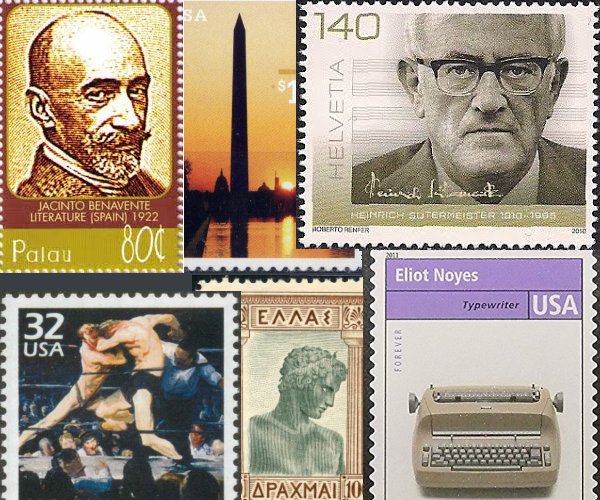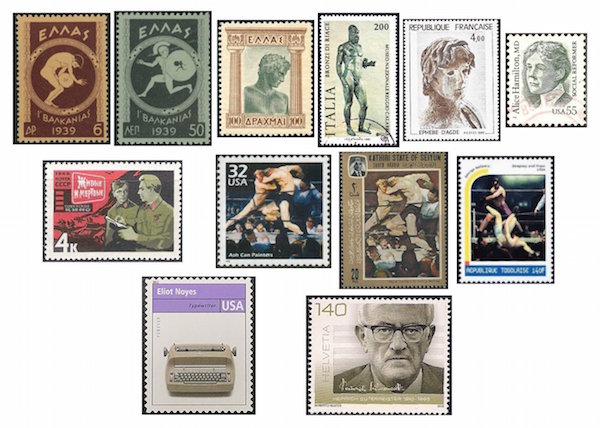The Arts on Stamps of the World — August 12
An Arts Fuse regular feature: the arts on stamps of the world.

By Doug Briscoe
I mentioned Robert Southey (12 August 1774 – 21 March 1843) the other day in connection with his friend Thomas Telford, but the poet has no stamp. There isn’t one for Cecil B. DeMille (August 12, 1881 – January 21, 1959), either.
So instead of Robert Southey or Cecil B. DeMille, how about Robert Mills? He was an American architect who designed the Washington Monument. He was born August 12, 1781 in South Carolina, where much of his later work, including eighteen county courthouses, would be done. At 19 he worked under Benjamin Henry Latrobe, who designed the U.S Capitol building, in Philadelphia and James Hoban, designer of the White House, in Washington, DC. Some of the other Philadelphia buildings Mills created are Washington Hall and at least two churches. In Baltimore he designed St. John’s Episcopal Church and the Maryland House of Industry, and in Washington the Department of Treasury building and the U.S. Patent Office Building. He won the competition to design the Washington Monument in 1836, but construction only began in 1848, then was interrupted in 1854. Resumption of the work picked up again 25 years later (!) for completion and dedication in 1885. Mills had by that time been dead for thirty years, having passed away on March 3, 1855. Mills was an early pioneer of fireproofing in design and construction.
Spanish dramatist Jacinto Benavente y Martínez (12 August 1866 – 14 July 1954) won the Nobel Prize for Literature in 1922. His first publications were a collection of plays, one of poems, one of short stories, and one of criticism, all dating from 1892-93. His breakthrough plays were El nido ajeno (Another’s Nest, 1894) and Gente conocida (High Society, 1896). He founded a Madrid theater in 1899 and went on to produce a prolific stream of plays, both tragic and comic. Although Benevente was a cofounder of the Spanish Association of Friends of the Soviet Union in 1933, he was essentially a monarchist and only reluctantly supported the Franco régime because of his mistrust of the republican government. He worked as a critic for various literary periodicals. Benavente is held by many to be the founder of modern Spanish theater.

There are no stamps for the important classicist Edith Hamilton (August 12, 1867 – May 31, 1963), author of The Greek Way (1930) and Mythology (1942), but there is a plenitude of them glorifying the accomplishments of ancient Greece. I show a sprinkling of these in tribute to her. Hamilton was born in Dresden, Germany to a Princeton and Harvard Law School grad father and a polyglot mother who loved literature. They returned to the U.S. (Fort Wayne, Indiana) while Edith was still a baby. Not surprisingly, she majored in Greek and Latin at Bryn Mawr and earned a degree in 1894. Later she taught there and became the college’s director. It was only on her retirement, at age 62 (!), that she began her writing career. Besides the aforementioned volumes, Hamilton also wrote The Roman Way (1932), The Prophets of Israel (1936), and The Echo of Greece (1957), among others. By the way, Hamilton’s sister Alice, who does have a stamp (shown), was “an expert in industrial toxicology and the first woman appointed to the faculty of Harvard University.” [Wikipedia]
Next we turn to the American realist painter George Bellows (August 12 or August 19, 1882 – January 8, 1925), a member of the “Ashcan School” of American art. Bellows was born and reared in Columbus, Ohio, with summer vacations at Sag Harbor. He might have been a pro baseball player but opted for art, studying with Robert Henri. He and other Henri pupils put together an exhibit of urban pieces that caused a stir in 1908. This type of painting is exemplified by The Cliff Dwellers (1913) and Bellows’s boxing pictures like Stag at Sharkey’s (1909), seen on stamps of the United States and the Kathiri State, and Dempsey and Firpo (1924) on a Togolese stamp. Bellows later began to be commissioned for portraits, and he did much work depicting the sea, such as The Fisherman (1917). He also taught at the first Modern School in New York City and the Art Institute of Chicago. A strong supporter of U.S. intervention in World War I, Bellows made some violent and extremely disturbing propagandistic pieces such as The Germans Arrive and The Barricade (both 1918). The Boston Public Library holds a substantial collection of the artist’s lithographs. Bellows died of appendicitis at age 43.
The Russian film director and screenwriter Aleksandr Stolper (12 August 1907 – 12 January 1979) was born in Dvinsk (now Daugavpils in Latvia). Of the 14 films he directed between 1940 and 1977 the best known is probably The Quick and the Dead (1964), which was recognized on a Soviet stamp two years after it was filmed.
The important American industrial designer Eliot Noyes (August 12, 1910 – July 18, 1977) was born here in Boston, grew up from infancy to age seven in Colorado, and then returned to Cambridge. His father taught English at Harvard, and his mother was a pianist. He hoped to become a painter but by age 19 had decided on architecture. Himself a Harvard grad, he worked for Walter Gropius and Marcel Breuer before joining New York’s Museum of Modern Art (MoMA) as director of industrial design. His first house was built in Dover, Massachusetts in 1941.
During World War II he worked on gliders for the Army Air Force. Later he oversaw projects for IBM, the most notable being the Selectric typewriter (1961) shown on the postage stamp.

Born on precisely the same day as Noyes, Heinrich Sutermeister (12 August 1910 – 16 March 1995) was a Swiss composer of opera who studied in Munich with and was heavily influenced by Carl Orff. His operas, including three for radio broadcast and three for television, were based on Shakespeare, Calderón, Rabelais, Dostoevsky, Oscar Wilde, Robert Louis Stevenson, Flaubert (Madame Bovary), and Eugène Ionesco. There are also three piano concertos, two for cello, one for clarinet, a Requiem, a Te Deum, and a handful of other works.
A graduate of the University of Massachusetts with a B.A. in English, Doug Briscoe worked in Boston classical music radio, at WCRB, WGBH, and WBUR, for about 25 years, beginning in 1977. He has the curious distinction of having succeeded Robert J. Lurtsema twice, first as host of WGBH’s weekday morning classical music program in 1993, then as host of the weekend program when Robert J.’s health failed in 2000. Doug also wrote liner notes for several of the late Gunther Schuller’s GM Recordings releases as well as program notes for the Boston Classical Orchestra. For the past few years he’s been posting a Facebook “blog” of classical music on stamps of the world, which has now been expanded to encompass all the arts for The Arts Fuse.
